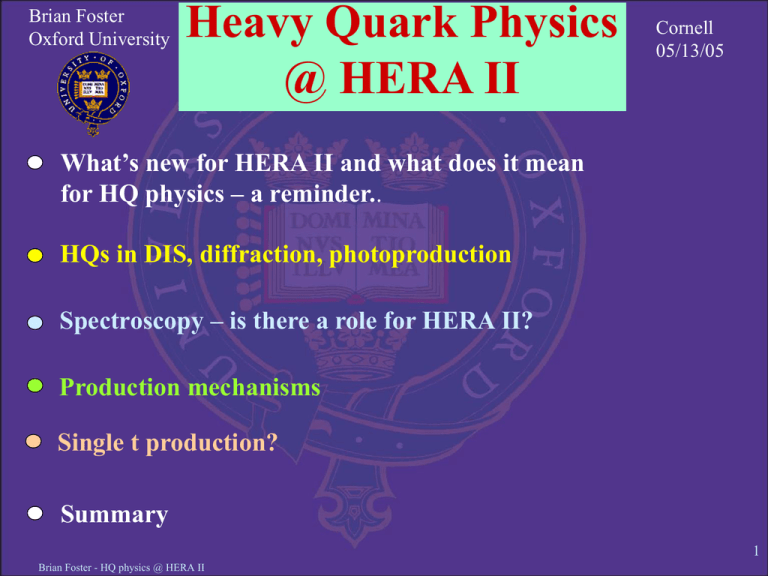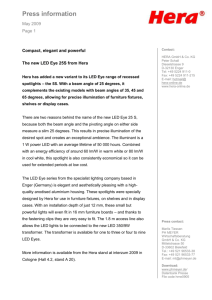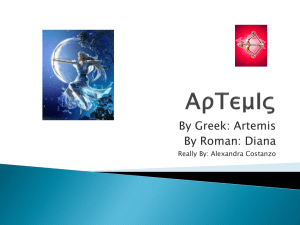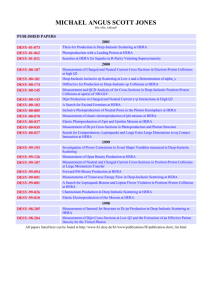Heavy Quark Physics @ HERA II for HQ physics – a reminder.
advertisement

Brian Foster Oxford University Heavy Quark Physics @ HERA II Cornell 05/13/05 What’s new for HERA II and what does it mean for HQ physics – a reminder.. HQs in DIS, diffraction, photoproduction Spectroscopy – is there a role for HERA II? Production mechanisms Single t production? Summary 1 Brian Foster - HQ physics @ HERA II HERA & experiments HERA @DESY in Hamburg 2 Brian Foster - HQ physics @ HERA II HERA II Physics Both ZEUS & H1 have made major upgrades in order to utilise the increase in HERA luminosity to the full. 3 Brian Foster - HQ physics @ HERA II Vertex Region The ZEUS MVD mostly 3 layers in barrel and 4 forward wheels; > 200K readout channels. 4 Brian Foster - HQ physics @ HERA II Vertex Region H1 Si – 2 very thin CST layers; 5 disks covering 8 < q < 17o 5 Brian Foster - HQ physics @ HERA II Forward Physics ZEUS major upgrade in forward direction replacement of TRD’s with two stations of straw-tube chambers, each with 3 stereo layers. H1 have made improvements to various parts of their tracking systems. 6 Brian Foster - HQ physics @ HERA II HERA II prospects So optimistically HERA II promised factor 5 increase in luminosity, with lepton polarisation, greatly improved tracking, DAQ and triggering. This implies generally order of magnitude improvement in statistics and increased kinematic range and coverage. The reality has been somewhat different. Major problems with backgrounds delayed then achievement of the design goals by almost 2 years - only now are we reaching, sometimes, 1pb-1 per day. What does all this mean for the physics reach of HERA II? 7 Brian Foster - HQ physics @ HERA II Low-x structure function data e(k) Kinematics Q2 = xys Q2 e'(k') g *(q) W2 xP p(P) s = k+P = energy in the ep c.m.s. Q2 = -(k-k')2 = -q2 = virtuality of the exchanged g x = Q2/(2P • Q) = fraction of proton momentum carried by the struck quark y = (P q)/(P k) = fraction of beam lepton energy transferred to the photon W 2 = ys ~ Q2/ x energy in the g*p c.m.s. • Brian Foster - HQ physics @ HERA II • 8 Inside the proton e e e e p remnant q Brian Foster - HQ physics @ HERA II e p p remnantp q p 9 Inside the proton Low Q2 (large l) Medium Q2 (medium l) Heisenberg’s UP allows gluons, and qq pairs to be produced for a very short time. Large Q2 (short l) At higher and higher resolutions, the quarks emit gluons, which also emit gluons, which emit quarks, which……. At highest Q2, l ~ 1/Q ~ 10-18 m Brian Foster - HQ physics @ HERA II 10 Inside the proton 11 Brian Foster - HQ physics @ HERA II F2 data ZEUS has very precise F2 data over 6 orders of magnitude in (x, Q2). 12 Brian Foster - HQ physics @ HERA II Inside the proton – the movie QuickTime™ and a BMP decompressor are needed to see this picture. 13 Brian Foster - HQ physics @ HERA II Parton evolution Factorization - hard processes can be regarded as convolution of “sub-process” cross section with probability to find participating partons in target & probe - subsequent hadronisation ~ independent process For DIS can (normally) consider virtual photon as d-function => s ~ f s where s is sub-process cross section f is parton dist. function, satisfying f/ m ~ f P (m = renormalisation scale, P is a splitting function) 14 Brian Foster - HQ physics @ HERA II Parton evolution In general Ps are perturbative expansions to particular orders, keeping terms most important for particular regions: m n n 1 ( n ) s ( n) xP ( x, s ) = Am ln x P ( x) x n = 0 2 m = 0 (n ) where P are AP splitting functions Leading ln Q2 terms come, in axial gauge, from evolution along parton chain strongly ordered in transverse momenta, terms - NLO sums LO DGLAP sums up terms which arise when two adjacent kts become comparable, losing factor ln Q2. 15 Brian Foster - HQ physics @ HERA II QCD evolution In small x region, leading terms in ln 1/x must be summed independent of Q2. This is done by the BFKL equation. LO (s ln 1/x)n terms arise from strong x ordering: xn << x(n-1) << x(n-2) … Generally, however, QCD coherence angular ordering work in unintegrated f(x,kt2,m2) - 2 hard scales more complicated CCFM evolution equation. DGLAP/BFKL two limits of angular ordering. DGLAP, q kt/kl, q grows since kt grows; in BFKL, q grows because kl x falls. 16 Brian Foster - HQ physics @ HERA II Dipole Models Much interest in dipole models & saturation. prest L.T. Breit, mom. In principle offers unification of inclusive DIS, diffraction 1g exchange + 2 g octet exchange Inclusive F2 Brian Foster - HQ physics @ HERA II 2 g singlet exchange Diffraction 17 HQ in DIS Specialise to HQ structure functions. There are many theoretical issues with how to include heavy quarks, in particular the mass thresholds; variations on the MVFN scheme a la Thorne&Roberts are currently favoured and have been examined at NNLO. 18 Brian Foster - HQ physics @ HERA II HQ in DIS We will need substantial part of the HERA II statistics to resolve many of the interesting issues in charm in DIS, even with substantial improvement in tagging efficiency. Thorne, Roberts 1998 The mechanism to take charm mass into account can give substantial mods. to theoretical expectation as function of Q2 at higher x. Intrinsic charm can also modify these predictions but unlikely we can get useful info. on this at HERA II. 19 Brian Foster - HQ physics @ HERA II HQ in DIS The D* tagging method in D* → Ks will still be useful although in general multiple scattering increases. However this will be more than offset by ability to use separated vertex or large impact parameter tag, as already demonstrated at HERA I by H1. 20 Brian Foster - HQ physics @ HERA II HQ in DIS HERA I has already told us a lot about the charm quark density inside the proton; very nice new H1 results at DIS05. 21 Brian Foster - HQ physics @ HERA II HQ in DIS H1 now using the power of their silicon tracker which was present in a modified form for the last few years of HERA I running - uses impact parameter tagging in 2-D to tag longlived quarks. 22 Brian Foster - HQ physics @ HERA II HQ in DIS H1 analysed 57 pb-1 of HERA I data using impact parameter. 23 Brian Foster - HQ physics @ HERA II HQ in DIS ~0.2% ~20% ~1% ~30% The fraction of c is more or less independent of Q2, whereas that of b is strongly rising. Both agree well with the the predictions from PDFs. ~4% ~20% 24 Brian Foster - HQ physics @ HERA II HQ in DIS Some of the open questions are obvious. 25 Brian Foster - HQ physics @ HERA II HQ in DIS Some were (much) more obscure. 26 Brian Foster - HQ physics @ HERA II HQ in DIS Fortunately, this seems to have gone away at HERA II. 27 Brian Foster - HQ physics @ HERA II HQ in DIS The promise of HERA II is great, since charm production in DIS is sensitive probe to all sorts of dynamical models. Saturation model of Kowalski & Teaney. 28 Brian Foster - HQ physics @ HERA II HQ in DIS - HERA II First HERA II results starting to come through. 29 Brian Foster - HQ physics @ HERA II HQ in DIS - HERA II First HERA II results starting to come through. 30 Brian Foster - HQ physics @ HERA II HQ in DIS Very precise measurements of F2C will be possible for HERA II; also gives accurate gluon determination and cross-check with the more global QCD fits. -1 -1 500 500 pbpb Accurate b contribution to F2 will become possible – cross-check of VFNS and clean test of photon-gluon fusion process. 31 Brian Foster - HQ physics @ HERA II HQ in DIS HERA II should allow both collaborations to make a full flavour decomposition of the inclusive F2 structure function. For example, charm signal in charged currents (expect ~ 50K events) in principle measures the s-quark density (+ leading particles in NC etc.; but also competing non-s diagrams from gluon splitting in CC). Constrain fit with s from leading f? At HERA II, both singlet & non-singlet pdfs - u,d,s (CC DIS) & c,b,g (NC DIS) - can be determined with good accuracy. Brian Foster - HQ physics @ HERA II 32 HQ & Polarisation Polarisation in DIS will be a unique tool @ HERA II for exploring EW couplings. In principle the spin orientation of the struck quark can carry through a memory into the final-state hadron. In c and b production, one can be sure that the struck quark is in one of the c or b hadrons and there is a correlation between the detected heavy-quark hadron and the struck quark. Using weak decay of Lc, can analyse for spin orientation of struck quark and hence disentangle spin-dependent ss. 33 Brian Foster - HQ physics @ HERA II HQ & Polarisation But first signal reported for inclusive Lc production from a substantial fraction of HERA I data makes it difficult to believe that statistically significant results can be obtained via this technique. 34 Brian Foster - HQ physics @ HERA II HQ in Diffraction The structure of diffraction and its mechanism and explanation in the framework of pQCD is one of the most fruitful areas of HERA I physics. In the charm sector, very strongly limited by statistics. However, also very good discrimination amongst models – one of the areas where we will most benefit from the statistics of HERA II. 35 Brian Foster - HQ physics @ HERA II HQ in Diffraction Charm production cf inclusive F2 will also be additional constraint on gluon pdf of diffractive exchange. In exclusive processes, the heavy c quark gives clearly different behaviour to light quarks – opening the relationship of QCD models of diffraction. One of the areas where one clearly sees the effect of mc as a hard scale. Again, in all of these studies, the statistics of HERA II will be decisive. Brian Foster - HQ physics @ HERA II 36 HQ in Photoproduction In general statistics not a problem with photoproduction results, except where extra requirements on tagging – e.g. double jet tags. Can use impact parameter tagging to isolate HQ sample in dijet events. Visible range: pt jet1(2) >11(8) GeV Measured quark fractions: fuds~58%, fc~35% , fb~7% Reach almost values expected for massless u,d,s,c,b ! 37 Brian Foster - HQ physics @ HERA II HQ in Photoproduction Differential cross sections can be compared to NLO QCD predictions. Higher pT reached than for D* measurements Excess Data/NLO in more forward direction 38 Brian Foster - HQ physics @ HERA II HQ in Photoproduction Study of angular distributions in dijet events where one of the jets contains a D* can disentangle the dynamics of the c-production process. In principle, this method, with greatly increased statistics at HERA II, can lead to determination of c (and g) density in g. Brian Foster - HQ physics @ HERA II 39 HQ in Photoproduction Since charm tagging works over a wide range of momenta, has rather high efficiency and high purity, charm is a useful method to look at fragmentation. The study of all these charm particles has allowed the determination of fragmentation probs. to u,d, ratios of P/V, strangeness suppression etc. to ~5 – 10%. This can certainly be improved at HERA II. Brian Foster - HQ physics @ HERA II 40 HQ in Photoproduction H1 data agrees well with that from e+e- - not surprisingly so do the fragmentation parameters deduced. 41 Brian Foster - HQ physics @ HERA II HQ in Photoproduction ZEUS published very similar results some time ago. More evidence that fragmentation factorises from the hard production process. 42 Brian Foster - HQ physics @ HERA II HQ in Photoproduction By looking at events containing leading neutrons and a charm tag, we can get a handle on the c (& g) density in the . This is a classic “double-tag” experiment which needs the increased statistics of HERA II (and more!). 43 Brian Foster - HQ physics @ HERA II B production B production both in photoproduction and DIS is really in its infancy at HERA I and will be a major study at HERA II. Whether there is really a problem with the QCD prediction of s(b) will surely have to wait for HERA II. Brian Foster - HQ physics @ HERA II 44 Charm spectroscopy in gp The large HERA I data sample gave the opportunity to make useful contributions to charm spectroscopy. Rich spectrum - D1 ,D2* established; D*' seen by DELPHI, not OPAL/CLEO. 45 Brian Foster - HQ physics @ HERA II Charm spectroscopy However HERA II can reach states that other machines cannot reach – e.g. states coupling strongly to gluons can be copiously produced at HERA. Not obvious why such states should want to decay to charm; but then we didn’t expect to see them in light-quark decays either. HERA II can do charm spectroscopy – we should look in those places where we are competitive. 46 Brian Foster - HQ physics @ HERA II Charm pentaquark? Many experiments have seen the strange pentaquark q(1530)K0s p ; many more haven’t. Some who did now aren’t so sure. H1 have signal for a charmed pentaquark. Acceptance corr. event yields Unambiguously ruled out by ZEUS. Needs HERA II. 47 Brian Foster - HQ physics @ HERA II Production mechanisms As an electron-proton collider, HERA II has access to unique production mechanisms that can provide strong tests of QCD. 48 Brian Foster - HQ physics @ HERA II Production mechanisms Interplay with Tevatron can give extra constraints on relative importance of CO & CS; large uncertainties in MEs mean not so obvious that HERA II statistics very helpful without significantly more theoretical work. Inelastic J/y photoproduction 49 Brian Foster - HQ physics @ HERA II Production mechanisms One process at least where we know HERA II will be vital, and which may well be a help in unraveling the J/y problems, is Υ production – at HERA I we barely (?) saw elastic production, let alone inelastic. 50 Brian Foster - HQ physics @ HERA II Single top production HERA cannot produce tt pairs and single production is highly suppressed in the SM – FCNC process. Observation of events with high pt lepton, jet and high missing pt sensitive to this process – and lots of other things. Brian Foster - HQ physics @ HERA II 51 Single top production As is well known, there is an excess of such events in H1, although not in ZEUS and not in either experiment in the hadron channel. 52 Brian Foster - HQ physics @ HERA II Single top production Summary of events seen to date - ZEUS numbers consistent with background. 53 Brian Foster - HQ physics @ HERA II Single top production This is perhaps the clearest and most important area where just the statistics gain (and the better b tagging) at HERA II will really pay dividends 54 Brian Foster - HQ physics @ HERA II HERA II prospects Heavy quark physics at HERA I has been exceptionally rich. Not only have we measured production cross sections over wide range of Q2, we have made contributions to QCD understanding of heavy quarks, to spectroscopy and to diffraction. HERA II promises much. There will be factors of ~5 in integrated luminosity; the tagging efficiency and kinematic reach for heavy quark measurements will increase because of the improvements to the detectors in general and the vertex detectors in particular. Many areas will benefit – particularly DIS and heavy quark structure functions, and everything to do with B production. 55 Brian Foster - HQ physics @ HERA II HERA II prospects The background problems are now solved and HERA is starting to work well; however a series of bending magnets is progressively failing and needs replacing in November. There have been problems with some of the upgraded parts of the detectors also. The ZEUS Straw Tube Tracker is currently switched off because insufficient cooling available and the thermal load on the superconducting coil was causing instabilities. This may be fixed during the shutdown coming in November. The H1 silicon tracker also has problems. Backward and forward detectors removed in summer and being upgraded with radhard chips. The FST wafers are also being replaced after damage in a beam accident. They will be reinstalled in December. 56 Brian Foster - HQ physics @ HERA II Summary There are only 2 years left until HERA will be switched off to become a synchrotron radiation facility. It’s going to be a race against time to achieve all the goals we set in HERA II - but things are now looking good. 57 Brian Foster - HQ physics @ HERA II Dipole Models Example of this type of model: Golec-Biernat & Wuesthoff predicts l 2 x l Q 2 x l Q 2 x Q s g p ( x, Q 2 ) = s 0 0 02 ln 2 1 ln 0 02 1 x0 Q0 x Q x Q * -Q2s0 58 Brian Foster - HQ physics @ HERA II



